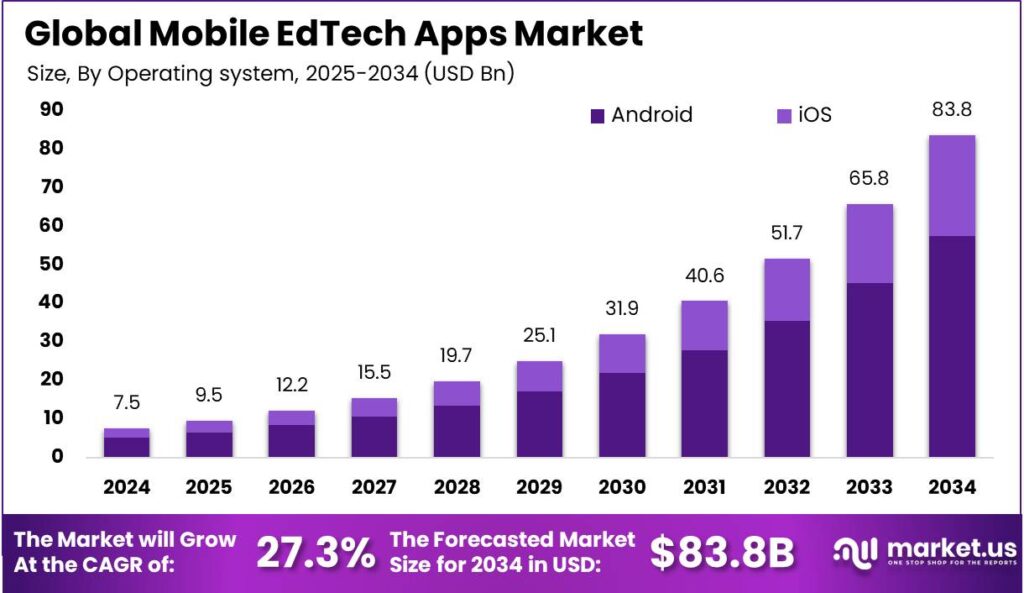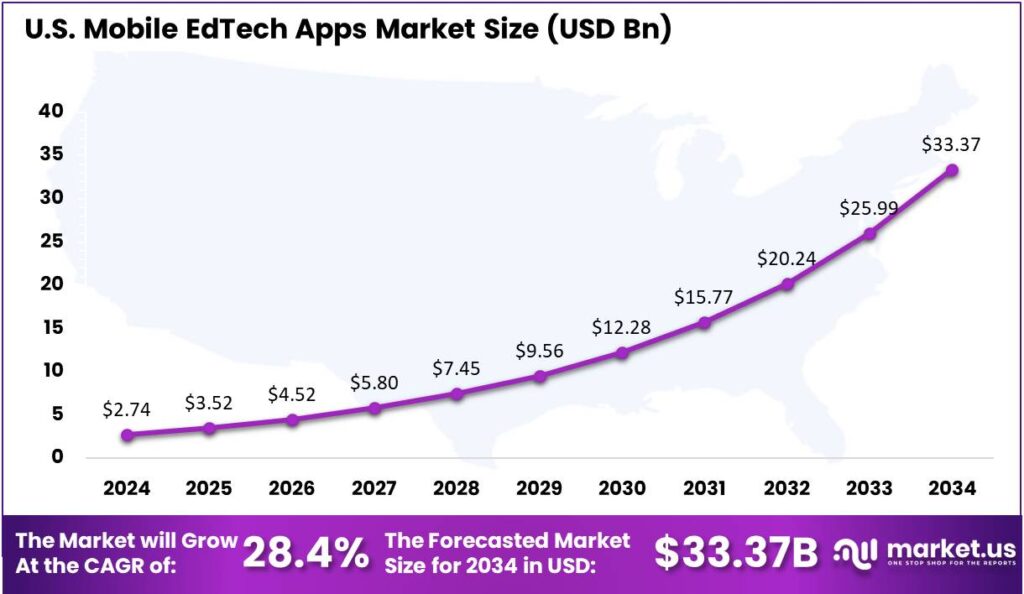Table of Contents
Report Overview
The Mobile EdTech Apps Market is set to skyrocket from USD 7.5 billion in 2024 to USD 83.8 billion by 2034, driven by a CAGR of 27.30%. In 2024, North America led the market with a 45.7% share, generating USD 3.4 billion, with the U.S. contributing USD 2.74 billion, solidifying its central role in the education sector.
Mobile EdTech apps are educational technologies designed to enhance the learning experience by integrating mobile computing and educational theory. These apps transform traditional educational settings by providing flexible, on-demand learning opportunities outside of the conventional classroom environment. They leverage the ubiquity of smartphones and tablets to deliver personalized, interactive educational content, making it accessible anywhere and anytime. This has made learning more dynamic, allowing for immediate application of knowledge in daily activities.
The market for mobile EdTech apps has grown significantly, driven by the increased adoption of mobile devices and the demand for personalized learning experiences. The market expansion is also fueled by the convenience of accessing educational materials on-the-go, which has become a necessity in today’s fast-paced world. Mobile EdTech apps not only cater to traditional students but also to professionals seeking continual education and skill enhancement.

The primary drivers of growth in the Mobile EdTech apps market include the rising demand for accessible education and the growing penetration of internet-enabled mobile devices. The flexibility offered by mobile apps, allowing users to learn at their own pace and on their own schedule, addresses the diverse needs of a global audience. Moreover, the shift towards digital learning platforms accelerated by the pandemic has highlighted the effectiveness of mobile apps in delivering education, further propelling their adoption.
There’s a significant demand for mobile EdTech apps that offer customized learning experiences tailored to the individual needs of users. This demand spans various demographics, including K-12 students, higher education learners, and professionals looking for continuous development. Features like interactive content, multimedia integration, and progress tracking are particularly sought after because they enhance engagement and improve learning outcomes.
The ongoing digital transformation in education presents numerous opportunities for developers and educational institutions to innovate and expand their reach. There’s a growing trend towards gamification, which makes learning more engaging through game-like elements such as points, badges, and leaderboards. Additionally, the integration of artificial intelligence can provide adaptive learning paths, personalized feedback, and automated content delivery, catering to the individual learning styles and paces of users.
Key Takeaways
- The global Mobile EdTech Apps market is projected to reach USD 83.8 billion by 2034, up from USD 7.5 billion in 2024, growing at a CAGR of 27.30% from 2025 to 2034.
- In 2024, the U.S. mobile EdTech apps market was valued at $2.74 billion, showcasing its significant role in the country’s education transformation.
- North America dominated the global market in 2024, holding a share of over 45.7%, generating around USD 3.4 billion in revenue.
- The Learning Management Systems (LMS) segment was the leader in 2024, accounting for over 25.4% of the market share.
- The Android platform led the market in 2024, capturing a dominant share of more than 68.7% in mobile EdTech apps.
- The K-12 Education segment was the largest in 2024, holding over 45.9% of the total mobile EdTech apps market share.
Analyst’s Viewpoint
The mobile EdTech app market presents significant opportunities as demand for accessible, flexible, and personalized learning experiences grows. With increasing smartphone penetration, especially in emerging markets, mobile apps can provide a wide range of educational tools, from K-12 content to professional skill-building and language learning. The shift towards remote learning, coupled with advancements in AI and gamification, allows for innovative, engaging solutions that cater to diverse learning styles, making this sector ripe for investment and growth.
Despite the promising growth, Mobile EdTech apps face several challenges. These include the high cost of app development and maintenance, the need for continuous technological upgrades, and concerns over data privacy and security. Ensuring accessibility and affordability of these apps across diverse socio-economic segments also remains a significant challenge. Additionally, the effectiveness of learning outcomes through these apps compared to traditional methods is still under scrutiny, which may affect adoption rates.
Technological advancements are critically shaping the Mobile EdTech sector. Innovations such as AI-driven personalization, gamification, and interactive learning models are enhancing user engagement and learning experiences. The Android platform, due to its affordability and flexibility, dominates the market, supporting a wide variety of educational apps tailored to different learning needs and regions.
Impact Of AI
- Bridging Educational Gaps: AI offers personalized support, helping to level the playing field for students from diverse backgrounds.
- Real-Time Problem Solving: AI assists students in tackling complex problems by providing step-by-step guidance.
- Adaptive Content Delivery: AI adjusts learning materials based on student performance, ensuring optimal understanding.
- Language Practice: AI enables realistic language conversations, enhancing speaking and comprehension skills.
- Resource Optimization: AI helps in creating efficient study plans, maximizing the use of available resources.
U.S. Mobile EdTech Apps Market Size
In 2024, the U.S. mobile EdTech apps market was valued at an impressive $2.74 billion, demonstrating the growing significance of mobile-based educational technologies in the country’s evolving learning ecosystem. This valuation reflects a notable shift toward digital learning tools, driven by advancements in mobile technology and the increasing demand for flexible, accessible education solutions.
As schools, universities, and individuals increasingly turn to mobile platforms for both formal and informal education, EdTech apps have become an essential part of the modern educational experience. These apps cater to a wide range of learners, from K-12 students to adult learners seeking skills development, thus addressing the diverse needs of the U.S. educational landscape.
The market’s robust growth is further highlighted by a remarkable compound annual growth rate (CAGR) of 28.4%. This growth rate underscores a rapidly accelerating adoption of mobile learning platforms, which has been fueled by several factors. One major driver is the widespread integration of technology into everyday life, including the ubiquity of smartphones and tablets.

In 2024, North America emerged as the leading region in the global mobile EdTech apps market, commanding an impressive 45.7% market share. This dominance was reflected in the significant revenue generation, with the region contributing around USD 3.4 billion.The strong performance of North America’s mobile EdTech sector is due to high technological adoption, a robust digital learning infrastructure, and the widespread use of smartphones and tablets among students, educators, and institutions.
The rapid growth of mobile EdTech apps in North America is also driven by the increasing demand for personalized learning experiences and the rising popularity of online education platforms. With educational institutions and organizations seeking innovative solutions to enhance learning outcomes, the demand for mobile apps that offer interactive features, flexible learning environments, and accessibility across devices has skyrocketed.
Furthermore, the significant investments in the development of AI-based learning tools and other advanced technologies have positioned North America at the forefront of this market, helping it maintain a dominant share globally.

Emerging Trends
- Personalized Learning Experiences: Mobile apps are increasingly using AI to create personalized learning pathways for students. These apps track progress and adjust content to match the learner’s pace and style. As a result, students can receive a more tailored educational experience that suits their unique needs.
- Gamification for Engagement: Many EdTech apps are integrating game-like features, such as rewards, levels, and challenges, to make learning more fun. This helps keep students engaged and motivates them to continue learning. Gamification also encourages a sense of achievement, improving overall retention rates.
- AR/VR for Immersive Learning: Augmented Reality (AR) and Virtual Reality (VR) are becoming more common in EdTech apps, offering immersive, hands-on learning experiences. These technologies allow students to interact with 3D models or explore virtual environments, enhancing understanding in subjects like science, history, and art.
- Microlearning and Bite-Sized Content: Mobile EdTech apps are shifting towards delivering lessons in short, digestible chunks rather than long sessions. This helps learners absorb information more effectively, especially for busy users who might only have a few minutes at a time. Microlearning fits perfectly into modern, on-the-go lifestyles.
- Focus on Social Learning: Many new apps are enabling collaborative learning through features like discussion forums, peer-to-peer feedback, and group projects. This approach encourages interaction and the sharing of ideas, which is known to boost understanding and critical thinking. Social learning can also help create a sense of community among learners.
Top Use Cases
- Personalized Learning: Mobile EdTech apps are designed to adapt to each learner’s pace and style. Whether a student is struggling with a specific topic or breezing through others, the app can provide customized lessons, quizzes, and resources to fit their unique needs. This makes learning more efficient and engaging.
- Interactive Learning: Many mobile EdTech apps feature gamified elements like quizzes, flashcards, and interactive lessons. These features not only make learning fun but also increase retention by keeping students engaged. The interactive nature encourages learners to practice regularly and track their progress.
- On-Demand Learning: With mobile apps, students can access educational content anytime and anywhere. Whether it’s for a quick review session or a deep dive into a topic, students can learn at their own convenience. This flexibility supports self-paced learning and helps people balance education with work or other responsibilities.
- Collaborative Learning: Mobile apps often include features that promote collaboration, such as discussion forums, group chats, or shared workspaces. Students can work together on projects, share notes, or ask questions. This collaborative environment mirrors a classroom setting but allows students to engage beyond traditional hours.
- Skill Development & Micro-Credentials: Mobile apps offer bite-sized courses and certifications that help learners pick up new skills, whether it’s coding, graphic design, or digital marketing. Many of these apps also offer micro-credentials or badges, allowing users to showcase their accomplishments on platforms like LinkedIn.
Attractive Opportunities
- Cost-Effective Education: Many educational apps offer free or affordable content, reducing the financial barriers to quality education.
- Language Learning: Apps like Duolingo have made language learning more accessible and enjoyable, reaching millions of users worldwide.
- Skill Development: Beyond traditional subjects, apps are available to teach coding, music, art, and other skills, catering to a wide range of interests.
- Real-Time Feedback: Immediate feedback on quizzes and exercises helps students understand their mistakes and learn more effectively.
- Collaboration Tools: Some apps offer platforms for students to collaborate on projects, fostering teamwork and communication skills.
Major Challenges
- Digital Divide: Despite the increasing popularity of mobile learning, not all students have access to the necessary devices or a stable internet connection. This inequality creates a barrier for many students who could benefit from mobile learning.
- User Engagement and Retention: Mobile EdTech apps often struggle with keeping users engaged. While students might download an app with good intentions, many abandon it due to a lack of personalized content or monotonous lessons that don’t hold attention.
- Data Privacy and Security Concerns: Since mobile EdTech apps collect sensitive personal information from students, they become prime targets for cyberattacks. Parents and educational institutions are concerned about how their data is being handled, and whether it’s adequately protected from breaches.
- Content Quality and Adaptability: Not all mobile learning apps offer high-quality content. There’s also the challenge of ensuring that content is adaptable to different learning styles. A one-size-fits-all approach rarely works in education.
- Scalability and Localization: Mobile EdTech apps often face difficulties when scaling to accommodate users from different regions. Cultural and language differences can create challenges in localizing content to make it relevant and effective for diverse audiences.
Market Opportunities for Key Players
- Personalized Learning: As education shifts toward customization, there’s a growing demand for apps that offer tailored learning experiences. Apps that adapt content to individual learning styles and pace can attract a larger user base, particularly in K-12 and higher education. This presents significant growth potential, especially with AI and machine learning integration.
- Skill Development & Lifelong Learning: There’s an increasing focus on skills-based education, as people look to upskill or reskill for career advancement. Mobile EdTech apps that offer certifications, vocational training, or language learning opportunities are well-positioned to capture this market. The demand for accessible, affordable learning is accelerating.
- Gamification & Interactive Learning: Incorporating gamified features into education apps boosts engagement and retention. Learners enjoy interactive elements, from quizzes to simulations. Mobile apps that effectively use game mechanics in educational content are likely to increase user loyalty and attract younger audiences.
- EdTech for Mental Health & Well-being: Mental health has become a priority in education. Apps focusing on mindfulness, stress management, and overall well-being are gaining traction. These apps not only serve students but also teachers and parents, making the market opportunity more expansive.
- Collaborative Learning Platforms: With remote and hybrid learning on the rise, apps that enable students to collaborate effectively online are in high demand. Platforms that offer group study sessions, peer interactions, and real-time feedback can address the gaps in traditional online learning environments.
Recent Developments
- June 2024: Class Over, a K-12 online course provider, merged with Battery Future Acquisition in a deal worth $135 million, indicating a trend towards consolidation among online education providers.
- May 2024: Follett School Solutions acquired MasterLibrary, a facility management platform, although the terms of this deal were not disclosed. This acquisition aims to enhance Follett’s offerings in managing educational facilities.
Conclusion
The mobile EdTech apps market has experienced significant growth, driven by the increasing demand for flexible and accessible learning solutions. As mobile technology becomes more advanced, apps offer diverse features such as personalized learning, interactive tools, and real-time feedback, making education more engaging and efficient for learners of all ages. The growing adoption of smartphones and tablets, coupled with the need for remote learning, has further accelerated the market’s expansion.
Looking ahead, the mobile EdTech apps market is poised for continued innovation, with emerging technologies like AI, AR, and VR offering new opportunities for enhanced learning experiences. As educational institutions, businesses, and individuals increasingly embrace these tools, the market is likely to see sustained growth, leading to further advancements in how knowledge is delivered and consumed globally.
Discuss your needs with our analyst
Please share your requirements with more details so our analyst can check if they can solve your problem(s)



